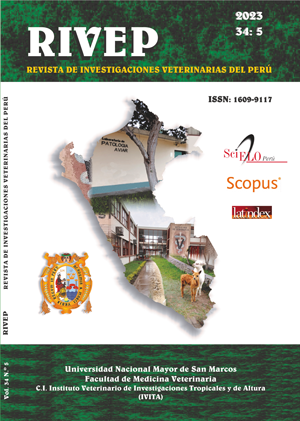Rest times of Panicum maximum and Brachiaria brizantha through three types of cutting
DOI:
https://doi.org/10.15381/rivep.v34i5.24237Keywords:
Brachiaria, rest period, grass production, regrowth, Saboya, varieties of grassesAbstract
The aim of this study was to determine the rest time of Savoy grass (Panicum maximum) and Brachiaria (Brachiaria brizanta) with three types of equalization cut and four rest times or days after the equalization cut. The research was carried out in Luz de América, Santo Domingo de los Tsáchilas province, Ecuador, during the dry season. The pastures were 7 years old, and the study factors were the grass varieties (Saboya and Brachiaria), types of cut (Machete, Scythe and Tractor) and days after the equalization cut (21, 28, 35 and 42 days). In total, 24 treatments with four repetitions each. The same management was carried out in all treatments (weed control, fertilization and initial cutting). Data collection was weekly, from days 21 to 42, using a quadrant of 1 m2. Plant height, green matter production, dry matter yield, bromatological analysis (protein, fat, ash, fibre and nitrogen-free extract) were evaluated. The results indicated that the peak of production of green matter and dry matter and height of the plant in the two varieties was on day 35; likewise, it was confirmed that the maximum cutting time of the pastures should be done until day 35, because the nutritional values tend to decrease with the age of the pasture. The Brachiaria variety cut with a tractor at 28 days, expressed the best nutritional contents of the grass, being therefore identified as the best forage option for the area in the dry season.
Downloads
Downloads
Published
Issue
Section
License
Copyright (c) 2023 Josselyn Lucero Pita, Gelacio Gómez Mendoza, Rocío Guamán Guamán, Ángel Villavicencio Abril, Santiago Ulloa Cortázar, Edison Javier Romero Salguero

This work is licensed under a Creative Commons Attribution 4.0 International License.
AUTHORS RETAIN THEIR RIGHTS:
a. Authors retain their trade mark rights and patent, and also on any process or procedure described in the article.
b. Authors retain their right to share, copy, distribute, perform and publicly communicate their article (eg, to place their article in an institutional repository or publish it in a book), with an acknowledgment of its initial publication in the Revista de Investigaciones Veterinarias del Perú (RIVEP).
c. Authors retain theirs right to make a subsequent publication of their work, to use the article or any part thereof (eg a compilation of his papers, lecture notes, thesis, or a book), always indicating the source of publication (the originator of the work, journal, volume, number and date).










